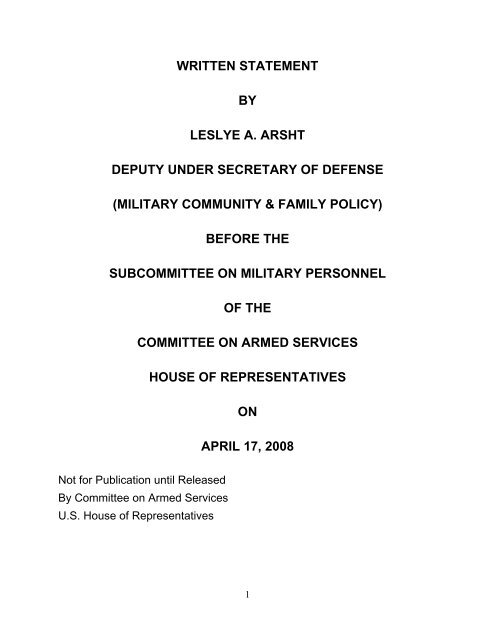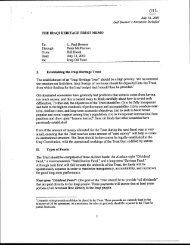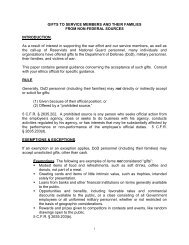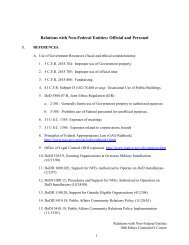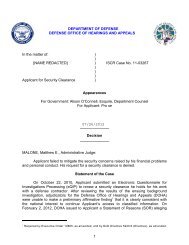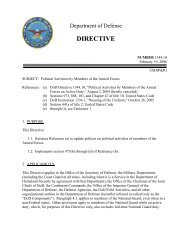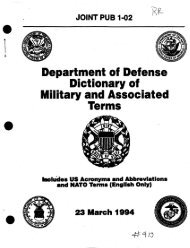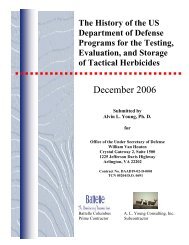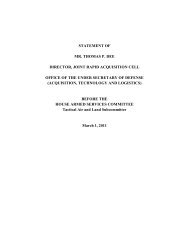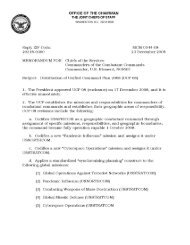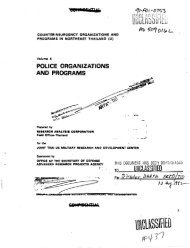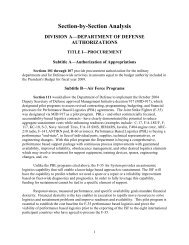Military Community and Family Program Support for Quality of Life
Military Community and Family Program Support for Quality of Life
Military Community and Family Program Support for Quality of Life
You also want an ePaper? Increase the reach of your titles
YUMPU automatically turns print PDFs into web optimized ePapers that Google loves.
WRITTEN STATEMENTBYLESLYE A. ARSHTDEPUTY UNDER SECRETARY OF DEFENSE(MILITARY COMMUNITY & FAMILY POLICY)BEFORE THESUBCOMMITTEE ON MILITARY PERSONNELOF THECOMMITTEE ON ARMED SERVICESHOUSE OF REPRESENTATIVESONAPRIL 17, 2008Not <strong>for</strong> Publication until ReleasedBy Committee on Armed ServicesU.S. House <strong>of</strong> Representatives1
Chairwoman Davis, Representative McHugh, <strong>and</strong> Distinguished Members <strong>of</strong> theSubcommittee, I am honored to appear be<strong>for</strong>e you to testify about the commissary,exchange, <strong>and</strong> morale, welfare <strong>and</strong> recreation (MWR) programs.The Department <strong>of</strong> Defense is committed to providing a high quality <strong>of</strong> life <strong>for</strong>military members serving our Nation <strong>and</strong> their families. In 2002, we published the firstDepartment <strong>of</strong> Defense Social Compact, recognizing the reciprocal relationship amongthe military mission, the individual Service member, <strong>and</strong> the family. The Social Compactembodies the notion "families also serve" <strong>and</strong> that the MWR, children <strong>and</strong> youth,commissary, exchange, <strong>and</strong> other family support programs have a pr<strong>of</strong>ound impact on themilitary quality <strong>of</strong> life <strong>and</strong> st<strong>and</strong>ard <strong>of</strong> living.I would like to begin by thanking the Subcommittee <strong>for</strong> its steadfast support inhelping the Department to advance <strong>and</strong> improve these programs <strong>for</strong> the past seven years.The Congress has provided tremendous support <strong>and</strong> the authorities needed <strong>for</strong> theDepartment to meet extraordinary dem<strong>and</strong>s to support our individual Service members<strong>and</strong> their families. We have garnered attention at the highest levels <strong>of</strong> our government.PRESIDENT'S INITIATIVESIn the State <strong>of</strong> the Union Address on 28 January, 2008, the President addressed thesacrifice <strong>of</strong> military families <strong>and</strong> acknowledged the responsibility <strong>of</strong> the nation to provide<strong>for</strong> our military families while their loved one is serving far from home. The President,in an unprecedented call <strong>for</strong> support <strong>for</strong> military families, asked that Congress exp<strong>and</strong>their access to child care, create new hiring preferences <strong>for</strong> military spouses across thefederal government, <strong>and</strong> allow service members to transfer their unused educationbenefits to their spouses or children. The Administration will soon transmit to Congressproposals to provide this additional support to military families.Child care is a major quality <strong>of</strong> life issue <strong>for</strong> military families. Active DutyService members have 1.2 million children <strong>and</strong> National Guard <strong>and</strong> Reserve members2
have 660,000 children. Statistics show that over 600,000 military children have had theirparent(s) deploy once <strong>and</strong> almost 500,000 children have had their parent(s) deploy morethan once. Newly <strong>and</strong> temporarily “single” parents need respite care; thous<strong>and</strong>s <strong>of</strong>infants born to working military spouses need care. We have a robust child care programin DoD <strong>and</strong> our child development services continue to be a national model; yet, we stillhave unmet dem<strong>and</strong> <strong>for</strong> thous<strong>and</strong>s <strong>of</strong> children.The Department has developed a plan to accelerate the child development centerconstruction program <strong>and</strong> to increase public-private ventures with nationally recognizedorganizations. A 3-pronged approach will be applied to meet the needs <strong>of</strong> the total <strong>for</strong>ce,including Reserve Component families who are facing deployment.First, in addition to the <strong>Military</strong> Construction (MILCON) program requests, anemergency intervention plan is underway to accelerate program availability throughconstruction <strong>of</strong> both temporary child development centers <strong>and</strong> permanent renovations.Presently, the Department operates 800 Child Development Centers at over 300geographic locations, both within the United States <strong>and</strong> overseas.Second, the Department is using the exp<strong>and</strong>ed minor military constructionauthority that the Congress has granted through Fiscal Year 2009. Under this temporaryauthorization, the Services initiated projects which will result in an increase <strong>of</strong> 1,785child care spaces.Third, the Department will continue public-private ventures with nationallyrecognized organizations such as the Boys & Girls Clubs <strong>of</strong> America (B&GCA), 4-H,The National Association <strong>of</strong> Child Care Resource <strong>and</strong> Referral Agencies (NACCRRA),ZERO TO THREE, National <strong>Military</strong> <strong>Family</strong> Association (NMFA) with OperationPurple camps, <strong>Military</strong> Child Education Coalition (MCEC), <strong>and</strong> Armed Services YMCA.The Department is exploring means <strong>of</strong> providing support to families <strong>and</strong>developing innovative new support systems. Strategies include:3
• <strong>Program</strong>s that “buy-down” the cost <strong>of</strong> high quality child care available in thelocal community.• Exp<strong>and</strong> existing partnerships with national youth organizations to obtain youthprograms <strong>and</strong> services.• Exp<strong>and</strong> weekend <strong>and</strong> short-term programs <strong>and</strong> services to support retention,mission readiness, <strong>and</strong> provide respite <strong>for</strong> families who stay behind.Education <strong>and</strong> training is a morale builder that helps sustain families financially<strong>and</strong> encourages people to make a life in the military. Spouse employment is a criticalfactor to the financial stability <strong>of</strong> military families.Our survey <strong>of</strong> active duty military spouses in 2006 not only confirmed that thevast majority <strong>of</strong> military spouses want to work (over 77%), but that they want a career.An overwhelming 87% <strong>of</strong> military spouses would like to further their education, but thecost <strong>of</strong> education is their primary reason <strong>for</strong> not enrolling in school or training. <strong>Military</strong>spouses earn on average three dollars per hour less than their civilian counterparts <strong>and</strong>their unemployment rate is three times as high. Contributing to this is the dramaticdifference in residence mobility between military <strong>and</strong> civilian wives; only about 10percent <strong>of</strong> military wives stay in the same home <strong>for</strong> five years; most move to anotherstate or overseas.In an ef<strong>for</strong>t to meet the educational needs <strong>of</strong> military spouses, the Departmentpartnered with the US Department <strong>of</strong> Labor on a demonstration program in eight states at18 installations. This three-year demonstration program provides military spouses withsupport <strong>for</strong> education, training <strong>and</strong> license/credentials (i.e., nursing <strong>and</strong> teachingcertificates) necessary to advance them into portable careers in Health Services,Education, In<strong>for</strong>mation Technology, Financial Services or Trades (e.g., electrician,plumber).4
PROGRESS AND OUTLOOKWe are managing considerable change <strong>and</strong> see progress being made on astaggering range <strong>of</strong> challenges <strong>and</strong> opportunities. From our military leaders, there is anunparalleled call <strong>for</strong> quality <strong>of</strong> life programs to accomplish the mission. The MWR,commissary <strong>and</strong> exchange programs are supporting military personnel <strong>and</strong> their familiesas the <strong>for</strong>ce mobilizes, deploys, <strong>and</strong> rotates in large numbers. The military community<strong>and</strong> our programs are adapting as we size, shape <strong>and</strong> posture globally <strong>and</strong> domestically.Our activities are meeting rising customer expectations <strong>for</strong>med by a global <strong>and</strong>networked marketplace. The programs are building partnerships <strong>and</strong> leveragingtechnology to reach out to the two-thirds <strong>of</strong> our active duty families who live <strong>of</strong>f-base,Guard <strong>and</strong> Reserve families who are not close to installations, our digital generation <strong>of</strong>members at remote locations around the world, <strong>and</strong> the over half <strong>of</strong> our military spouseswho work. All <strong>of</strong> this is being accomplished during the longest period <strong>of</strong> time that ourAll Volunteer Force has been at war. We still have much work to do.One <strong>of</strong> our most resounding successes has been <strong>Military</strong> OneSource, our 24/7telephone <strong>and</strong> Internet site <strong>for</strong> Service members <strong>and</strong> their families. <strong>Military</strong> OneSourcedelivers in<strong>for</strong>mation <strong>and</strong> referrals on the full array <strong>of</strong> quality <strong>of</strong> life support <strong>and</strong> isespecially beneficial to those geographically separated from installation services or thosewho are unable to seek assistance during traditional work hours.<strong>Military</strong> OneSource <strong>of</strong>fers free, convenient access to confidential resource <strong>and</strong>referral support <strong>for</strong> Service members <strong>and</strong> their families <strong>and</strong> recently deployed a worldwidetelephonic consultation capability as an additional option <strong>for</strong> those unable to attendface-to-face counseling sessions. The areas most frequently addressed are deploymentrelated:parenting, child care, financial management <strong>and</strong> permanent change <strong>of</strong> stationissues. Last year, approximately 550,000 Service members filed their federal incometaxes using the <strong>Military</strong> OneSource on-line tax filing service – we surpassed that numberlast month <strong>for</strong> 2007 tax returns.5
MWR, COMMISSARY AND EXCHANGE PROGRAMSThe MWR, commissary, <strong>and</strong> exchange systems are designed to meet the day today needs <strong>of</strong> our Service members <strong>and</strong> their families <strong>and</strong> must be capable at all times <strong>of</strong>supporting our <strong>for</strong>ces deployed throughout the world. These systems support over 12million authorized patrons at nearly 300 military installations in over 30 countries <strong>and</strong>military missions on board 157 ships <strong>and</strong> in 82 contingency operations.MWR programs encompass a wide array <strong>of</strong> mission essential, community support<strong>and</strong> business operations. Participation in recreation, fitness, sports, cultural arts <strong>and</strong> otherleisure activities is the key to active living, which leads to improved personal health <strong>and</strong>well-being <strong>and</strong> helps build strong military families <strong>and</strong> healthy communities. Activeliving can also reduce stress, loneliness, <strong>and</strong> depression <strong>and</strong> builds positive self-esteem<strong>and</strong> esprit de corps, so critical in the military environment. <strong>Family</strong> <strong>and</strong> spousal support<strong>and</strong> assistance programs, although closely affiliated <strong>and</strong> <strong>of</strong>ten managed with the MWRprograms, are separate community programs on the installations that help families adaptto life in the military.The commissary <strong>and</strong> exchange programs, or “the resale system,” are eachcomponents <strong>of</strong> the military compensation <strong>and</strong> benefit package <strong>and</strong> are importantcontributors to morale <strong>and</strong> readiness. The Defense Commissary Agency (DeCA)operates a world-wide system <strong>of</strong> commissary stores that sell name br<strong>and</strong> grocery <strong>and</strong>household necessities to military personnel <strong>and</strong> their families, who save an average 30percent on their purchases. The <strong>Military</strong> Services run three world-wide Exchangesystems that operate retail complexes, catalogs, <strong>and</strong> web sites that sell a wide range <strong>of</strong>merch<strong>and</strong>ise <strong>and</strong> services to the military community, on board ships <strong>and</strong> in contingencyoperations. The exchanges price their goods to average at least 15 percent savings to thecustomer <strong>and</strong> to produce revenues to help finance the MWR programs.6
Collectively, these programs contribute to the readiness <strong>and</strong> retention <strong>of</strong> the total<strong>for</strong>ce while supporting the well-being <strong>of</strong> their families. These programs comprise theinterconnected framework <strong>of</strong> the military family <strong>and</strong> community support structure. Theseprograms must work together as partners to overcome shared challenges <strong>and</strong> to fulfilltheir unique missions. As we move <strong>for</strong>ward, continued Congressional support will becritical to our success.PROGRAM OVERSIGHTAs indicated in earlier testimonies to Congress, investment in our people is vital.The <strong>Military</strong> Departments recognize their fiduciary responsibility to provide theresources <strong>and</strong> set the direction <strong>and</strong> goals to sustain the MWR <strong>and</strong> exchange benefits <strong>for</strong>the ultimate stakeholders, the military members. Each <strong>Military</strong> Service supervises theirExchange <strong>and</strong> MWR programs through a board <strong>of</strong> directors, except <strong>for</strong> the Air ForceMWR program which is overseen by the Manpower, Personnel, <strong>and</strong> Services staff. The<strong>Military</strong> Departments, through their representation on the DeCA Board <strong>of</strong> Directors,advise the Under Secretary <strong>of</strong> Defense <strong>for</strong> Personnel <strong>and</strong> Readiness on the funding <strong>and</strong>operation <strong>of</strong> the commissary system <strong>and</strong> assist in the overall supervision <strong>of</strong> DeCA.We take great pride in our important mission <strong>and</strong> in the tremendous ef<strong>for</strong>ts <strong>of</strong> the130,000 employees <strong>of</strong> DeCA, the Army <strong>Family</strong> Morale, Welfare <strong>and</strong> RecreationComm<strong>and</strong>, the Army <strong>and</strong> Air Force Exchange Service (AAFES), the Navy InstallationsComm<strong>and</strong>, the Navy Exchange Service Comm<strong>and</strong> (NEXCOM), the Headquarters U.S.Air Force Services, <strong>and</strong> the Headquarters Marine Corps Personal <strong>and</strong> <strong>Family</strong> ReadinessDivision. Their amazing work is making a difference in the quality <strong>of</strong> life <strong>of</strong> ourSoldiers, Sailors, Airmen, Marines <strong>and</strong> families.In partnership with the Congress, I am confident that we have the leadership, theresources, <strong>and</strong> the drive necessary to see these important programs through thesechallenges. The Department places great confidence in the leadership <strong>of</strong> these7
organizations, who also testify today. This team, with many new players, brings a wealth<strong>of</strong> experience <strong>and</strong> commitment to guide their organizations <strong>and</strong> to work together toguarantee future success.APPROPRIATED BUDGET REQUESTSThe President’s budget submission continues the Department’s strong support <strong>for</strong>Service members <strong>and</strong> their families. The Fiscal Year 2009 President’s Budget requests$4.006 billion to operate the commissary, exchange, MWR, child care <strong>and</strong> youthprograms. The DeCA FY 2009 budget request is $1.2911 billion, which covers the$1.3009 billion operating budget, adjusted <strong>for</strong> prior years. The $245.6 million requested<strong>for</strong> the Armed Service Exchanges includes $179.5 million to fully support transportationrequirements to ship U.S. procured goods to overseas locations, as is required by the law.The <strong>Military</strong> Departments request $2.1 billion <strong>for</strong> direct support <strong>of</strong> the MWR programs,with $969 million designated to support child <strong>and</strong> youth development programs. Inaddition, the Fiscal Year 2009 budget requests $375.1 million <strong>of</strong> MILCON <strong>and</strong> $138million <strong>of</strong> Base Realignment <strong>and</strong> Closure (BRAC) funding <strong>for</strong> commissary, child care,fitness, recreation, <strong>and</strong> lodging facilities.RESALE SYSTEM OVERSIGHTThe commissaries <strong>and</strong> exchanges exist as government entities to deliver resultsthat can not be entirely furnished by the private sector. We must, there<strong>for</strong>e, continue todemonstrate that our commissaries <strong>and</strong> exchanges, individually <strong>and</strong> in aggregate, aremeeting the needs <strong>of</strong> our Service members <strong>and</strong> are contributing positively to recruiting,retention, <strong>and</strong> readiness. We set long term goals <strong>and</strong> monitor program per<strong>for</strong>mancethrough the DeCA Board <strong>of</strong> Directors, the respective Exchange Boards, <strong>and</strong> within my<strong>of</strong>fice. The commissary <strong>and</strong> exchange per<strong>for</strong>mance are components <strong>of</strong> the <strong>Quality</strong> <strong>of</strong>8
<strong>Life</strong> Social Compact Improvement Index in the Per<strong>for</strong>mance Accountability Report <strong>and</strong>the Department’s Annual Report to the President <strong>and</strong> the Congress.The Defense Manpower Data Center periodically surveys our customers tounderst<strong>and</strong> how they value commissary <strong>and</strong> exchange benefits. In addition, theDepartment uses the American Customer Satisfaction Index (ACSI), a nationallyrecognized measure <strong>of</strong> customer satisfaction that includes the largest U.S. retailers, as ageneral measure <strong>of</strong> satisfaction with the commissary <strong>and</strong> exchange benefits. These tools,along with the customer satisfaction assessments by the commissaries <strong>and</strong> exchanges,help us identify improvement opportunities. The Department is encouraged by theResale systems’ initiatives to invest in technologies, partner with other programs, <strong>and</strong>exp<strong>and</strong> communication channels that will give customers more in<strong>for</strong>mation about bestvalue <strong>and</strong> better access to their resale benefits.Executive Resale Board. The Executive Resale Board advises the USD(P&R) onthe complementary operation <strong>of</strong> commissary <strong>and</strong> exchange systems. Since its membersmay also serve on the Commissary Operating Board <strong>and</strong> the Exchange boards, theExecutive Resale Board provides valuable insight where there are mutual interests. TheExecutive Resale Board reviews joint construction projects, resale in<strong>for</strong>mation systemst<strong>and</strong>ards, resale cooperative ef<strong>for</strong>ts, combined store operations, <strong>and</strong> evaluatesmerch<strong>and</strong>ise authorized <strong>for</strong> sale, including the results <strong>of</strong> the impulse merch<strong>and</strong>ise test incommissaries.We recently reported the two-year test results <strong>for</strong> the ten commissaries sellingfilm, one-time use cameras, <strong>and</strong> telephone cards. Although we have not ruled out sellingother items in the commissaries, the test did not indicate strong customer support <strong>for</strong> thecommissaries to continue selling these particular items. Also, based on Boardrecommendations, the Department initiated a process to resolve competing interests overmerch<strong>and</strong>ise that is not clearly delineated between commissaries <strong>and</strong> exchanges. Thesereviews, along with the recent evaluations <strong>of</strong> combined stores, have encouraged progressin other areas that may provide value to commissary <strong>and</strong> exchange patrons worldwide.9
The Resale Comm<strong>and</strong>ers are exploring new opportunities to operate collaboratively, suchas cross promotion <strong>of</strong> merch<strong>and</strong>ise <strong>and</strong> services <strong>and</strong> exp<strong>and</strong>ing on-site events <strong>for</strong> theGuard <strong>and</strong> Reserve.Defense Commissary Agency Oversight. The DeCA Board <strong>of</strong> Directors providescritical advice on the commissary stores needed by the <strong>Military</strong> Services, managementinitiatives to improve DeCA’s per<strong>for</strong>mance, <strong>and</strong> priorities <strong>for</strong> investing surcharge fundsin systems <strong>and</strong> construction. The Board closely monitors the $5.5475 billion resale stockfund <strong>and</strong> the $1.3009 billion operating budget to ensure that DeCA is fundedcommensurate with its mission <strong>and</strong> the support provided to each Armed Service.DeCA’s strong stewardship <strong>of</strong> taxpayer dollars has been demonstrated by the sixthconsecutive unqualified audit opinion <strong>of</strong> its financial records.Under the Board supervision, DeCA's management has a proven track record <strong>of</strong>achieving per<strong>for</strong>mance goals. Since 2000, DeCA steadily increased sales, improved thequality <strong>and</strong> availability <strong>of</strong> goods, sustained capital investment, <strong>and</strong> reduced costs throughbusiness process improvements – all while leading the grocery industry in customersatisfaction ratings <strong>and</strong> delivering customer savings averaging over 31 percent. Thesavings, while slightly down <strong>for</strong> all categories except produce in the U.S., climbedoverseas due to the unfavorable currency exchange rate. Under the Office <strong>of</strong>Management <strong>and</strong> Budget (OMB) <strong>Program</strong> Assessment Rating Tool (PART), DeCA’sPART Improvement Plan continues to focus on maintaining long-term customersatisfaction <strong>and</strong> reducing costs by restarting DeCA's competitive sourcing program in2009.Armed Service Exchanges Oversight. The exchanges are making progress towardproducing more st<strong>and</strong>ardized per<strong>for</strong>mance measures against program <strong>and</strong> financial goalsestablished by their <strong>Military</strong> Services. Each <strong>of</strong> the exchanges is improving businessprocesses <strong>and</strong> modernizing technology to improve program delivery, operate moreeffectively, <strong>and</strong> to remain competitive in a challenging retail market. In addition, theirBoards are pursuing enduring partnerships among the exchanges to improve customer10
service <strong>and</strong> maximize efficiencies in systems, logistics, <strong>and</strong> supply. For example, under acooperative initiative, customers can now redeem gift cards in all exchange activitiesanywhere in the world.The audited financial statements report that the exchanges are in sound financialcondition, with St<strong>and</strong>ard <strong>and</strong> Poors ratings <strong>of</strong> A-1+. We continue to monitor exchangepr<strong>of</strong>itability <strong>and</strong> MWR dividends, which surpassed the FY 2007 goals. The NEXCOMexpects to sustain these higher levels in FY 2008. The AAFES <strong>and</strong> the MCX expectpr<strong>of</strong>its <strong>and</strong> dividends to decline in FY 2008. All the exchanges are exceeding the goalsset by their boards <strong>for</strong> savings to the customers <strong>and</strong> customer satisfaction. Customersatisfaction improved significantly <strong>and</strong> average savings to customers are now 20 percentor better – well above the 15 percent target.CHILD CARE, YOUTH AND FAMILY PROGRAMSThe child care <strong>and</strong> youth programs are crucial elements <strong>of</strong> the MWR communitysupport functions, providing service on a daily basis <strong>for</strong> the largest number <strong>of</strong> children <strong>of</strong>any employer in the United States. Readily available, quality <strong>and</strong> af<strong>for</strong>dable child care<strong>and</strong> youth programs are a work<strong>for</strong>ce issue with direct impact on mission readiness <strong>and</strong>mobilization preparedness, especially in today's higher operations tempo. Our families,like their civilian counterparts, include dual working couples <strong>and</strong> single-parent families.The military child care system includes services both on <strong>and</strong> <strong>of</strong>f installations: installationChild Development Centers; in-home family child care; school-age care, <strong>and</strong> resource<strong>and</strong> referral partnership programs.The Department continues to lead the nation with ninety-seven percent <strong>of</strong> DoDChild Development Centers accredited by the National Academy <strong>of</strong> Early Childhood<strong>Program</strong>s, as compared to 8%-10% <strong>of</strong> civilian child care centers. To be accredited, earlychildhood programs voluntarily undergo a comprehensive self-study <strong>and</strong> an external,pr<strong>of</strong>essional review. Criteria are aimed at providing a safe <strong>and</strong> nurturing environment11
while promoting the physical, social, emotional <strong>and</strong> intellectual development <strong>of</strong> youngchildren. Additionally, a report released by the National Association <strong>of</strong> Child CareResources <strong>and</strong> Referral Agencies in March 2007 rated the DoD child care systemoversight <strong>and</strong> st<strong>and</strong>ards as the top ranking among all 50 states <strong>and</strong> the District <strong>of</strong>Columbia with a score <strong>of</strong> 117 out <strong>of</strong> 150 points, 27 points ahead <strong>of</strong> its nearestcompetitors (New York <strong>and</strong> Illinois).Youth <strong>Program</strong>sThe Department <strong>of</strong> Defense has a long history <strong>of</strong> providing positive youthprograms that focus on alternative activities <strong>for</strong> youth during out-<strong>of</strong>-school hours.<strong>Military</strong> Youth programs support the needs <strong>of</strong> school age children, older youth <strong>and</strong> teens,thereby resulting in reduced duty time <strong>for</strong> Service members due to conflict betweenparental responsibility <strong>and</strong> mission requirements. Youth programs <strong>and</strong> services also helpminimize lost duty time due to youth misconduct during out <strong>of</strong> school hours, <strong>and</strong> have apositive influence on families.Youth <strong>Program</strong>s <strong>of</strong>fer a unique <strong>and</strong> wide variety <strong>of</strong> educational, recreational,cultural <strong>and</strong> social activities <strong>for</strong> youth between the ages <strong>of</strong> 6 <strong>and</strong> 18. Today, DoDprovides more than 350 dynamic youth programs worldwide. DoD promotes positiveyouth development by designing programs to recognize the achievements <strong>of</strong> youth <strong>and</strong> bydeveloping partnerships with other youth-serving organizations such as the Boys & GirlsClubs <strong>of</strong> America <strong>and</strong> 4-H that <strong>of</strong>fer a variety <strong>of</strong> resources. <strong>Program</strong>s prepare teens <strong>and</strong>pre-teens to meet the challenges <strong>of</strong> military life, adolescence, <strong>and</strong> adulthood. <strong>Program</strong>sinclude physical fitness <strong>and</strong> sports, arts <strong>and</strong> recreation, training in leadership, life skills<strong>and</strong> career/volunteer opportunities, mentoring, intervention <strong>and</strong> support services. Manyprograms <strong>of</strong>fer summer day camp programs <strong>and</strong> youth employment.The construction <strong>of</strong> additional youth facilities will allow DoD to exp<strong>and</strong>programming <strong>for</strong> youth. The 2008 Youth Center construction projects, totaling $127million in nonappropriated funds (NAF), constitute a critical aspect <strong>of</strong> supportingfamilies by providing additional facilities to meet youth program needs. We recently12
<strong>for</strong>warded an “out <strong>of</strong> cycle” request <strong>for</strong> fifteen youth center projects at Army installationsto better serve youth in after school programs <strong>and</strong> to help meet 35 percent <strong>of</strong> the youthdem<strong>and</strong> by FY09.Each <strong>of</strong> the <strong>Military</strong> Services has developed on-going partnerships with nationallyrecognized youth organizations such as the Boys & Girls Clubs <strong>of</strong> America (B&GCA)<strong>and</strong> 4-H, that <strong>of</strong>fer well-established, research based programs. These organizations <strong>and</strong>programs are easily accessible to geographically isolated military families <strong>and</strong> ReserveComponent members who do not live near an active installation. Strong partnershipswith local school systems provide additional support to youth whose parent or loved-onehas deployed. <strong>Program</strong>s designed to provide a safe place <strong>for</strong> youth during the summermonths contribute to a comprehensive approach <strong>of</strong> providing support to youth. A fewmajor initiatives include:• Operation <strong>Military</strong> Kids (OMK) - a collaborative ef<strong>for</strong>t with America’s communitiesto support Reserve Component children <strong>and</strong> youth be<strong>for</strong>e, during, <strong>and</strong> after thedeployment <strong>of</strong> a parent or loved one. OMK Teams in 42 states locate <strong>and</strong> serveReserve Component youth living in the local community utilizing community supportnetworks such as the American Legion <strong>and</strong> local Veterans’ service organizations,B&GCA, county 4-H Agents <strong>and</strong> local clubs, the <strong>Military</strong> Child Education Coalition<strong>and</strong> state <strong>and</strong> local schools, <strong>and</strong> the National Association <strong>of</strong> Resource <strong>and</strong> ReferralAgencies (NACCRRA). The teams work together to increase the community’scapacity to support youth when the Service member is deployed.• Speak Out <strong>for</strong> <strong>Military</strong> Kids – includes state OMK Teams working with nearly 2,300citizens within the state to better underst<strong>and</strong> the military lifestyle, to identifycommunity support services needed during the military deployment cycle, <strong>and</strong> toidentify resources to help military children <strong>and</strong> youth cope with the stress <strong>of</strong> absentparents who may be in harm’s way.• State <strong>Military</strong> Liaisons – 4-H <strong>Military</strong> Liaisons have been established in every state toserve as a link between the resources <strong>of</strong> the L<strong>and</strong> Grant University Extension System13
<strong>and</strong> <strong>Military</strong> Child <strong>and</strong> Youth <strong>Program</strong>s. State 4-H <strong>Military</strong> Liaisons lead the OMKState teams.• Mission: Youth Outreach - A Services sponsored youth outreach initiative with theB&GCA allows geographically dispersed Reserve Component youth to attend a localBoys & Girls Clubs (B&GC) at no cost. B&GCs provide a safe <strong>and</strong> positive place <strong>for</strong>youth to spend their out-<strong>of</strong>-school time. Youth <strong>and</strong> teens have access to all B&GCprograms <strong>and</strong> may participate in local <strong>and</strong> national events.• Youth <strong>of</strong> the Year is a recognition program administered by the Army, Marines,Navy, <strong>and</strong> Air Force in conjunction with the B&GCA. The Youth <strong>of</strong> the Yearprogram recognizes youth’s outst<strong>and</strong>ing contributions to a member’s family, school,community <strong>and</strong> youth center, as well as personal challenges <strong>and</strong> obstacles overcome.National Guard <strong>and</strong> Reserve youth participate in Youth <strong>of</strong> the Year events.• Training <strong>for</strong> School Personnel includes “<strong>Support</strong>ing Children <strong>of</strong> the National Guard<strong>and</strong> Reserve” Institutes, two-day <strong>for</strong>ums designed to provide pr<strong>of</strong>essionaldevelopment <strong>for</strong> school educators, guidance counselors, <strong>and</strong> family support specialistswho work with the National Guard <strong>and</strong> Reserve. The school-based training isconducted by the <strong>Military</strong> Child Education Coalition (MCEC), a non pr<strong>of</strong>itorganization, <strong>and</strong> is designed to respond to the needs <strong>of</strong> the “suddenly military” child.Institute <strong>of</strong>ferings have been concentrated in eleven states <strong>and</strong> areas most affected bydeployments. More than 1,100 school personnel have attended the Army, MCEC, <strong>and</strong>State sponsored institutes.• School <strong>Support</strong> Services vary by location <strong>and</strong> need. In Hawaii, families <strong>of</strong> activatedSoldiers were served by the Deployment Response Team. Overseas, impact on schooltransitions were improved when the Department <strong>of</strong> Defense Dependent Schools(DoDEA) changed policy to allow Reserve Component military members activated<strong>for</strong> more than 180 days to enroll their children in DoDEA Schools. Additionally,14
Domestic Dependent Elementary <strong>and</strong> Secondary Schools in Guam were able toaccommodate children <strong>of</strong> activated Reserve Component Members.• Operation Purple Camps – National <strong>Military</strong> <strong>Family</strong> Association (NMFA) withfunding from private foundations developed this no cost summer camp program inresponse to the need <strong>for</strong> increased support <strong>for</strong> military children, especially thosewhose parents are or will be deployed. Specific curricula were designed to helpchildren develop strategies <strong>for</strong> coping with their parent’s deployment.Future <strong>of</strong> Warfighter <strong>and</strong> <strong>Family</strong> Service <strong>Program</strong>sAs discussed earlier, unlike child <strong>and</strong> youth programs, Warfighter <strong>and</strong> <strong>Family</strong>Services (WFS) programs are not part <strong>of</strong> the Department's MWR reporting structure.Taken together MWR <strong>and</strong> WFS programs build the social fabric <strong>of</strong> the militarycommunity <strong>and</strong> provide an integrated approach to service delivery <strong>for</strong> troops <strong>and</strong> families<strong>and</strong> comprehensive support to comm<strong>and</strong>ers. The Department is currently working withMWR <strong>and</strong> WFS programs <strong>of</strong> the <strong>Military</strong> Departments to review all opportunities <strong>for</strong>greater flexibility in the use <strong>of</strong> resources, <strong>and</strong> will seek future congressional support toachieve the goal <strong>of</strong> flexible support to MWR <strong>and</strong> WFS programs.SUPPORTING GUARD, RESERVE AND GEOGRAPHICALLY DISPERSEDPERSONNELWe continue to emphasize programs that target our geographically dispersedmilitary personnel <strong>and</strong> their families, including the National Guard <strong>and</strong> Reserves. TheJohn Warner National Defense Authorization Act <strong>for</strong> FY 2007 required the Departmentto carry out a joint family support assistance program <strong>for</strong> families <strong>of</strong> members <strong>of</strong> theArmed Forces in not more than six areas <strong>of</strong> the United States, <strong>of</strong> which up to three <strong>of</strong> theareas were to be geographically isolated from military installations. To address this, theDepartment launched a pilot program in six states (Arkansas, Hawaii, Minnesota, NewHampshire, Ohio, <strong>and</strong> Oregon). The response was overwhelmingly positive <strong>and</strong> an15
additional nine states were included (Alabama, Cali<strong>for</strong>nia, Colorado, Florida, Indiana,Nebraska, Tennessee, Texas <strong>and</strong> West Virginia). We are taking steps to open theprogram in all 50 states, as it serves as the primary underpinning to the newCongressional direction <strong>for</strong> Yellow Ribbon reintegration. This initiative created a "hightech,high touch" web-enabled community to connect military families with each other<strong>and</strong> with supportive resources 24/7 regardless <strong>of</strong> where families are located.Additionally, the initiative enhances the availability <strong>of</strong> resources <strong>for</strong> family members byaugmenting the activities <strong>of</strong> active duty <strong>and</strong> Guard <strong>and</strong> Reserve family centers <strong>and</strong>programs. Partnering with the Red Cross, this program facilitates a federal, state <strong>and</strong>local team that can <strong>of</strong>fer benefits <strong>and</strong> transition assistance throughout each <strong>of</strong> theparticipating states.Providing child care <strong>for</strong> the Reserve <strong>and</strong> Guard presents unique challenges. Manyfamilies do not live close enough to military installations to use on-base child care <strong>and</strong><strong>of</strong>f-base care is not always af<strong>for</strong>dable. The availability, af<strong>for</strong>dability, <strong>and</strong> access to highquality programs <strong>for</strong> children <strong>and</strong> youth are critical elements <strong>of</strong> support <strong>for</strong> families <strong>of</strong>the National Guard <strong>and</strong> Reserves. An initiative designed to address these challenges isOperation: <strong>Military</strong> Child Care, which reduces but does not fully subsidize the cost <strong>of</strong>child care. Services are provided through partnership with a national nonpr<strong>of</strong>itorganization that helps parents locate child care, at reduced rates in their owncommunities, when they are unable to access child care on military installations.Direct mailings, <strong>Military</strong> OneSource, unit events, <strong>and</strong> the Internet are used toin<strong>for</strong>m Guard <strong>and</strong> Reserve members about the value <strong>of</strong> their commissary <strong>and</strong> exchangebenefits. Joint commissary <strong>and</strong> exchange special events, such as “case lot” <strong>and</strong> “tentsales,” also attract geographically dispersed personnel, including retirees, to our retailcomplexes on military installations. To increase Guard <strong>and</strong> Reserve accessibility to thecommissary benefit without costly infrastructure, DeCA is exp<strong>and</strong>ing their “on-site”truckload sales <strong>and</strong> on-line grocery ordering programs. In Fiscal Year 2007, DeCAintroduced “on site” truckload sales at 21 Guard <strong>and</strong> Reserve locations that are not near a16
military installation. There are plans to significantly increase the number <strong>of</strong> Guard <strong>and</strong>Reserve events this year, with participation by the exchanges. The exchange catalog <strong>and</strong>Internet stores <strong>of</strong>fer another way <strong>for</strong> our military community to remotely access theirexchange benefits.The Department is exploring other ways to exp<strong>and</strong> the military MWR benefit toactive duty, Guard <strong>and</strong> Reserves who do not have access to installation MWR programs.This includes on going ef<strong>for</strong>ts to establish national partnerships to provide discounts <strong>for</strong>fitness <strong>and</strong> recreation programs. We are working with many non-pr<strong>of</strong>it organizations thatprovide recreation <strong>and</strong> also the National Recreation <strong>and</strong> Park Association, as the nation'sleading pr<strong>of</strong>essional association <strong>for</strong> personnel working in community, <strong>and</strong> military parks<strong>and</strong> recreation programs. The goal: to create awareness within State <strong>and</strong> localcommunities on the need to engage military personnel <strong>and</strong> their families, who do nothave access to installation-based MWR programs that promote active, healthy lifestyles<strong>and</strong> create a sense <strong>of</strong> community. We also plan to better use <strong>Military</strong> OneSource as avirtual one-stop-shop <strong>for</strong> recreation opportunities - both those found in the localcommunity <strong>and</strong> installation based MWR programs that can be accessed <strong>of</strong>f theinstallation, such as the virtual library materials <strong>and</strong> discounted tickets, hotels, <strong>and</strong> travelopportunities.MIGRATING TO THE NEW GLOBAL POSTURE AND DOMESTICSTRUCTUREBase closure <strong>and</strong> realignment (BRAC), restationing, <strong>and</strong> Grow the Force mayrequire changes to our activities that support domestic <strong>and</strong> overseas militarycommunities. DoD is partnering with other Federal Agencies <strong>and</strong> the affected civiliancommunities to <strong>for</strong>mulate quality <strong>of</strong> life programs at locations where there will be asufficient concentration <strong>of</strong> active duty members. We recognize that access to benefits isa pressing concern <strong>for</strong> communities after bases close <strong>and</strong> realign. We would continue anoperation only if there is a significant active duty population remaining in the area that17
would otherwise not be supported. As a general rule, we do not continue commissary,exchange or MWR operations after an installation closes. By divesting the operationsthat are no longer required to support active duty missions, resources can be redirected tosupport the military communities that will experience a significant increase <strong>of</strong> active dutypersonnel.Implementing Joint BasingFor the twelve joint installations created under BRAC legislation, we are workingwith the <strong>Military</strong> Departments <strong>and</strong> the installation comm<strong>and</strong>ers to manage the change.The initial implementation guidance was recently issued. We are nearing completion <strong>of</strong>the supplemental guidance <strong>for</strong> nonappropriated fund instrumentalities <strong>and</strong> civilian humanresources to ensure processes used to implement Joint Bases are effective <strong>and</strong> fair.Supplemental guidance will specifically address the concerns raised by the Services, theaffected installations, <strong>and</strong> the Subcommittee. We will report those results to the Defensecommittees, as you have requested.The warfighter <strong>and</strong> family services, lodging programs <strong>and</strong> a portfolio <strong>of</strong> MWRactivities, to include children <strong>and</strong> youth, will merge at all but one location (Fort Myer/Henderson Hall). The programs will be provided to Service members <strong>and</strong> their familiesbased on an assessment <strong>of</strong> mission, demographics, geography, <strong>and</strong> market requirements<strong>of</strong> each Joint Base. The Components are collaborating to develop common st<strong>and</strong>ards <strong>and</strong>levels <strong>of</strong> support <strong>for</strong> fourteen major MWR mission sustaining programs (Category A),warfighter <strong>and</strong> family services, <strong>and</strong> community support programs (Category B), children<strong>and</strong> youth development programs, <strong>and</strong> lodging. These DoD-wide st<strong>and</strong>ards will first beintroduced at joint bases, as a means to provide consistent quality, available, <strong>and</strong>af<strong>for</strong>dable programs, regardless <strong>of</strong> military affiliation. The exchange operations are notmerged at joint bases, so exchange earnings should be unaffected. The Components willadjust their dividends when necessary to ensure equitable distribution to MWR programsat joint bases18
Supplemental Civilian Human Resources guidance ensures that DoD installationsinvolved in joint basing take into account the mix <strong>of</strong> APF employees, NAF employees,military members, <strong>and</strong> DoD contractors who currently accomplish the functions affectedby the joint basing action, <strong>and</strong> work to mitigate adverse effects on employees. Theguidance addresses labor relations obligations, potential reductions in <strong>for</strong>ce, transfer <strong>of</strong>function <strong>and</strong> transfer <strong>of</strong> work, work classifications, <strong>and</strong> NAF personnel issues. NAFemployers participated in the development <strong>of</strong> supplemental guidance applicable tononappropriated positions, which will address placement procedures in the new JointBase organization, separation <strong>and</strong> severance pay, <strong>and</strong> portability <strong>of</strong> NAF retirementbenefits.Commissary <strong>and</strong> Exchange Stores at Closed InstallationsUnder DoD policy, commissary <strong>and</strong> exchange operations are generally closedwhen an installation closes. Independent commissaries <strong>and</strong> exchanges may be authorizedto continue operations at a closed installation where there is a significant Active Dutypopulation, the nearest installation authorized support is over 20 miles away, no newconstruction is required, there is local community support, <strong>and</strong> other specific criteria aremet. Exchanges must be pr<strong>of</strong>itable.Where independent operations can not be continued at closed installations, the lawallows the exchanges to operate up to ten “combined commissary <strong>and</strong> exchange stores”that sell groceries at cost plus 5 percent, with DeCA providing up to 25 percent <strong>of</strong> theprevious APF support <strong>for</strong> the location to <strong>of</strong>fset grocery losses. Under this authority, theexchanges operated four “combined stores” <strong>for</strong> many years. Three <strong>of</strong> the four locationshave closed, due to persistent financial losses that lowered dividends to MWR. Werecently notified the Congress <strong>of</strong> our intention to close <strong>and</strong> convert the last location to anindependent exchange operation.Our exhaustive reviews have not produced a successful model <strong>for</strong> combiningcommissary <strong>and</strong> exchange stores as a way to continue operations at BRAC locations inthe United States. Several studies, conducted by the Resale Comm<strong>and</strong>ers at the request19
<strong>of</strong> the Executive Resale Board, concluded that the grocery losses could not be fully <strong>of</strong>fsetby the level <strong>of</strong> appropriations permitted by law <strong>and</strong> that a statutory change wouldsacrifice the savings identified within the BRAC recommendations. A concept <strong>for</strong> thecommissary <strong>and</strong> exchange to operate within a “shared facility” would also lowerexchange pr<strong>of</strong>its <strong>and</strong> dividends to MWR <strong>and</strong> increase DeCA’s APF costs. TheDepartment plans to determine future operating <strong>for</strong>mats, on a case by case basis, withinthe current statutory <strong>and</strong> policy structure.Commissary Openings <strong>and</strong> ClosuresDeCA currently operates 259 stores worldwide. The commissary system isoperated entirely with appropriations <strong>and</strong> goods are sold at cost plus a 5 percentsurcharge. This fiscal structure is designed to save military families an average 30percent <strong>and</strong> produce $279 million annually to support capital investment in store systems<strong>and</strong> shopping facilities. Within these funding constraints, the Department must assurethat criteria are met when establishing new operations, including a full-time active dutymission <strong>and</strong> at least 100 active duty personnel are assigned to the installation. TheDepartment has never waived this policy <strong>and</strong> has no plans to change it.Under these criteria, the Department established a commissary store at Naval AirStation, Joint Reserve Base, Fort Worth, Texas on March 25, 2008 in conjunction withthe disestablishing <strong>of</strong> the AAFES operated combined store. Two commissaries havealready closed in Fiscal Year 2008: Buedingen <strong>and</strong> Gelnhausen, Germany. In FiscalYear 2009, one commissary is scheduled to close due to BRAC <strong>and</strong> three commissariesare planned to close in Germany. There are five additional commissaries scheduled toclose in 2010 – 2011, due to installation closures under BRAC action.FACILITIES REQUIREMENTSIt is essential to have predictable <strong>and</strong> adequate funding <strong>for</strong> construction <strong>and</strong>sustainment, restoration, <strong>and</strong> modernization <strong>of</strong> facilities. During preparation <strong>of</strong> the Fiscal20
provide savings to the customer <strong>and</strong> to produce revenues at a level set by their <strong>Military</strong>Service to sustain exchange capitalization requirements <strong>and</strong> to help finance their MWRprograms. Collectively, the exchanges estimate pr<strong>of</strong>its <strong>of</strong> $628 million <strong>for</strong> the retail year2007, which closed at the end <strong>of</strong> January 2008. The exchanges continue to plan <strong>for</strong>capital investment averaging $528 million per year, with $158 million identified <strong>for</strong>in<strong>for</strong>mation technology modernization <strong>and</strong> $370 million designated <strong>for</strong> facilities <strong>and</strong>equipment. On a combined basis, the exchanges plan to distribute $349 million (56percent) <strong>of</strong> their 2007 pr<strong>of</strong>its as dividends, up from $316 million in FY 2006. Dividendsare projected to fall to $283 million in Fiscal Year 2008.The MWR programs plan to increase their average capital investment to $401million per year, with $24 million identified <strong>for</strong> in<strong>for</strong>mation technology modernization<strong>and</strong> $377 million designated <strong>for</strong> facilities <strong>and</strong> equipment. In addition, the Lodgingprogram is planned to increase average capital investment to $230 million per year, with$222 million designated <strong>for</strong> facilities <strong>and</strong> equipment.MORALE, WELFARE AND RECREATION (MWR) FUNDINGWithin Secretary <strong>of</strong> Defense policy <strong>and</strong> fiscal guidance, each <strong>Military</strong> Servicemanages <strong>and</strong> funds its MWR program using a combination <strong>of</strong> appropriated <strong>and</strong>nonappropriated resources. The continued vitality <strong>of</strong> the MWR programs depends onsound management, meeting comm<strong>and</strong> <strong>and</strong> customer needs, a predictable stream <strong>of</strong> NAFrevenues, <strong>and</strong> also solid APF support <strong>of</strong> Category A <strong>and</strong> B activities.All the <strong>Military</strong> Departments report that their MWR programs were pr<strong>of</strong>itable inFiscal Year 2007. The combined MWR pr<strong>of</strong>its <strong>of</strong> $117 million represent a $73 millionincrease over Fiscal Year 2006. Fiscal Year 2007 APF <strong>of</strong> $2.1 billion, with $1.5 billionin direct support, represents 51 percent <strong>of</strong> total MWR program costs. The remaining 49percent <strong>of</strong> MWR program costs was supported with NAFs. However, not all <strong>of</strong> the23
Services met the minimum DoD st<strong>and</strong>ard percentages <strong>of</strong> appropriated support <strong>for</strong>Categories A <strong>and</strong> B activities.Category A activities (fitness, libraries, recreation centers, single Service memberprograms, intramural sports, <strong>and</strong> unit activities) should be entirely funded withappropriations. The Department sets a minimum st<strong>and</strong>ard requiring at least 85 percent <strong>of</strong>total expenses being supported with APF. The Army achieved 83 percent in FY 2007.Category B activities (child <strong>and</strong> youth development programs, outdoor recreation, crafts<strong>and</strong> hobby shops, <strong>and</strong> small bowling centers) should be supported with a minimum APF<strong>of</strong> 65% <strong>of</strong> total expense. This year, Navy dropped below the minimum st<strong>and</strong>ard with 61percent <strong>and</strong> the Air Force had 64 percent.The FY 2008 APF budget is $1.7 billion in direct funding <strong>for</strong> MWR programs, <strong>of</strong>which $660 million is <strong>for</strong> child <strong>and</strong> youth development programs, <strong>and</strong> there are 7MILCON projects totaling $120 million. The FY 2009 MWR budget request <strong>for</strong> directsupport is $2.1 billion dollars, with most <strong>of</strong> the increase going to child <strong>and</strong> youthdevelopment programs. The FY 2009 budget request includes 36 construction projects<strong>for</strong> $448 million funded from appropriations, with $96 million to support thoseinstallations gaining populations under base realignment, closure, <strong>and</strong> restationingactions.MWR PROGRAM INITIATIVES.Our MWR programs continue to evolve to meet the contemporary needs <strong>of</strong> ourmembers <strong>and</strong> their families. These programs are vibrant <strong>and</strong> reflect the diverse leisuretime interests <strong>of</strong> our modern day <strong>for</strong>ce <strong>of</strong> combat veterans <strong>and</strong> families.Libraries: Online library portals provide continuous access to academic materials,regardless <strong>of</strong> location. Virtual resources are located on the Army's General LibraryIn<strong>for</strong>mation System, the Navy's Library Multimedia Resource Centers on ships, <strong>and</strong> theAir Force’s Learning Resource Centers. This service greatly enhances the outreach24
capabilities <strong>of</strong> the Department's 207 installation libraries. Currently 103 libraries meetone hundred percent <strong>of</strong> DoD core st<strong>and</strong>ards <strong>and</strong> this number increases each year. Ofparticular note, all <strong>of</strong> Marine Corps libraries meet DoD st<strong>and</strong>ards <strong>and</strong> they are the onlyService to have three libraries with certified "DoD premiere status."The Department recently launched a Lean Six Sigma study <strong>of</strong> library materialpurchases, to ensure that DoD takes advantage <strong>of</strong> economies <strong>of</strong> scale, since purchase <strong>of</strong>paper or electronic recreation materials varies among the Services. DoD is funding ajoint purchase <strong>of</strong> library materials, recommended by the Service librarians, to jumpstartthis initiative <strong>and</strong> immediately make available more library materials to deployed troops<strong>and</strong> active duty, guard <strong>and</strong> reserve members <strong>and</strong> their families. This joint procurementadds to the Services’ collections <strong>of</strong> electronic <strong>and</strong> audio books, <strong>and</strong> provides several databases that include animated e-books <strong>for</strong> children (three years through high school age),do-it-yourself reference centers <strong>for</strong> home <strong>and</strong> auto repairs, career planning, <strong>and</strong> lifelonglearning centers. These materials will be able to be downloaded through <strong>Military</strong>OneSource <strong>and</strong> from the Services library portals, making them available virtuallyanywhere.Single Service Member <strong>Program</strong>s: The Department also underst<strong>and</strong>s theimportance <strong>of</strong> focusing ef<strong>for</strong>ts on single Service members, not just families. Our singleService members tell us they enjoy exercising, electronic social networking, weekendtrips, music, computer games, movies, <strong>and</strong> high adventure sports. Single ServiceMember programs are targeted to 18-25 year olds <strong>and</strong> provide opportunities to socializewith friends, learn new skills, travel, <strong>and</strong> experience new adventures in <strong>and</strong> out <strong>of</strong> themilitary community.Fitness: Based on Defense-wide fitness st<strong>and</strong>ards, all <strong>of</strong> the military Servicescontinue to exp<strong>and</strong> <strong>and</strong> provide innovative fitness programs that sustain a physically fit,healthy <strong>for</strong>ce in our military communities <strong>and</strong> <strong>for</strong> deployed men <strong>and</strong> women around theworld. Long term plans will modernize the fitness infrastructure beginning with the25
Services request <strong>for</strong> seven fitness center MILCON projects in FY 2008 <strong>and</strong> another 67fitness centers programmed through FY 2013.Pr<strong>of</strong>essional entertainment: Entertainment helps build morale <strong>and</strong> nowhere isthis support more important than in the austere locations where Service members areper<strong>for</strong>ming duty. Armed Forces Entertainment (AFE), in cooperation with the USO,continues to provide much welcomed celebrity <strong>and</strong> pr<strong>of</strong>essional entertainment to our<strong>for</strong>ces overseas. In 2007, AFE conducted 130 tours with 1300 shows in over 25countries. Nineteen <strong>of</strong> those tours were with USO coordination. Entertainers includedGary Sinise, World Wrestling Entertainment, Harlem Globetrotters, Bret Michaels <strong>of</strong>Poison, Comedy Corps <strong>and</strong> numerous other b<strong>and</strong>s, comedians, <strong>and</strong> entertainment groups.Each <strong>of</strong> the military Services also provides entertainment opportunities both in theUnited States <strong>and</strong> overseas. The Spirit <strong>of</strong> America Tour provides a brief reprieve fromthe stresses <strong>of</strong> deployments at military installations within the continental United States.From 2002 through 2007, the Robert <strong>and</strong> Nina Rosenthal Foundation worked closelywith the country music industry to provide 92 celebrity entertainment shows at no cost tomilitary personnel <strong>and</strong> their families. Through this program, per<strong>for</strong>mers, such as ClintBlack, Travis Tritt, Dennis Miller, Oakridge Boys <strong>and</strong> many others have givengenerously <strong>of</strong> their time <strong>and</strong> talents.In<strong>for</strong>mation <strong>and</strong> Leisure Travel: The Department has 342 In<strong>for</strong>mation, Ticket<strong>and</strong> Tours (ITT)/Travel <strong>of</strong>fices located worldwide to encourage military personnel <strong>and</strong>their families to get out <strong>and</strong> enjoy their duty location wherever it may be. Experiencedstaffs provide in<strong>for</strong>mation brochures, advice <strong>and</strong> <strong>of</strong>ten reservations <strong>for</strong> local <strong>and</strong> regionalattractions; local or regional group tours; discounted tickets to local movie theaters,concerts, plays, sports events, museums; admission to regional or national theme parks;<strong>and</strong> discounted hotels, resorts, <strong>and</strong> even cruises. Customers consistently rank ITT/Travel<strong>of</strong>fices as an important MWR benefit as it can help provide significant savings <strong>for</strong> theindividual or family entertainment <strong>and</strong> travel budget.26
Return <strong>and</strong> Recreate: The Department, working with the Services, recognizedthe need to develop a post-deployment recreational program. Service members returningfrom the intense conditions <strong>of</strong> war can get their adrenaline pumping <strong>and</strong> fill their bodieswith good endorphins in our high-adventure recreation programs, like rappelling, rockclimbing, mountain biking, jet skiing, white-water rafting, paintball, or windsurfing.With free time <strong>for</strong> the first time in a long time, they have many choices on how to spendit, including MWR outdoor recreation programs. The Army, <strong>for</strong> example has createdWarrior Adventure Quest (WAQ), which <strong>of</strong>fers high adventure programs that are fun,challenging, supervised, <strong>and</strong> provided in a safe environment. WAQ is currently targeted<strong>for</strong> fourteen installations with high rates <strong>of</strong> deployment; family members can alsoparticipate.Heroes to Hometowns: The American public's strong support especially shows intheir willingness to help Service members who are severely injured in the war <strong>and</strong> theirfamilies as they transition from the hospital environment <strong>and</strong> return to civilian life.Heroes to Hometowns' focus is on reintegration back home, with networks established atthe national <strong>and</strong> state levels to better identify the extraordinary needs <strong>of</strong> returningfamilies be<strong>for</strong>e they return home. They work with local communities to coordinategovernment <strong>and</strong> non-government resources necessary <strong>for</strong> long-term success.The Department has partnered with the National Guard Bureau, The AmericanLegion <strong>and</strong> the National Association <strong>of</strong> State Directors <strong>of</strong> Veterans Affairs, to tap intocorporate <strong>and</strong> non-pr<strong>of</strong>it resources at all levels to garner community support. <strong>Support</strong> hasincluded help with paying bills, adapting homes, finding jobs, arranging welcome homecelebrations, help navigating through the bureaucracy, providing entertainment options,mentoring, <strong>and</strong> most importantly, garnering hometown support.Adaptive sports <strong>and</strong> recreation: The ability <strong>of</strong> injured Service members to engagein recreational activities is a very important component <strong>of</strong> recovery. We continue towork with the United States Paralympics Committee <strong>and</strong> other organizations so that ourseverely injured have opportunities to participate in adaptive sports programs, including27
skiing, running, hiking, horseback riding, rafting, or kayaking. We are also mindful <strong>of</strong>the need to ensure installation MWR programs can accommodate the recreation needs <strong>of</strong>our severely injured Service members <strong>and</strong> their families. Recreation programming <strong>for</strong>injured troops is underway at installations with Warrior Transition Units <strong>and</strong> MWR staffsare increasingly partnering with local communities to develop programs to benefit thereturning warfighter suffering from mental <strong>and</strong> physical injuries. Additionally, atCongressional request, we studied the current capabilities <strong>of</strong> MWR programs to provideaccess <strong>and</strong> accommodate eligible disabled personnel <strong>and</strong> have initiated plans to makeavailable adaptive golf carts <strong>for</strong> use on military golf courses.DEPLOYMENT SUPPORTInternet Service: The ability to communicate with families <strong>and</strong> friends is thenumber one factor in being able to cope with longer <strong>and</strong> more frequent deployments.When deployed, service members have free access to the non-secure military Internet byusing their military e-mail address, including aboard ships. They also have free Internetaccess at 560 MWR Internet cafes in Iraq, increasing to 885 cafes by September 2008 <strong>and</strong>45 MWR Internet cafes in Afghanistan, growing to 65 cafes in September. This willrepresent increases <strong>of</strong> 264 percent <strong>and</strong> 117 percent respectively in the number <strong>of</strong> Internetcafes operating since 2006.MWR Internet cafes <strong>of</strong>fer webcams <strong>and</strong> headsets so they can make video calls <strong>and</strong>voice calls over Internet at less than $.04 per minute. During the past year, theDepartment funded an increase in satellite b<strong>and</strong>width to provide better speed <strong>and</strong>reliability, <strong>and</strong> antennae size was increased to allow more data to be sent over the Internetusing less power. Service members have access to You-Tube, MySpace, Facebook, <strong>and</strong>all the popular, widely used websites to better communicate with family <strong>and</strong> friends.MWR Internet cafes are also being installed in Education Centers, so Service memberscan complete on-line classes <strong>and</strong> conduct research. In addition, the Marine Corpslaunched MotoMail, a HQMC-sponsored regular mail alternative program developed to28
support deployed Marines <strong>and</strong> families. Through this enhanced capability, individualscan access an established web site <strong>and</strong> deliver a letter to deployed Marines in 24 hours orless.Back home, computers <strong>and</strong> Internet service located in our family support centers,recreation centers, installation libraries, <strong>and</strong> youth centers help ensure families can send<strong>and</strong> receive e-mails from their deployed loved ones. In fact, between home computers<strong>and</strong> family support <strong>and</strong> MWR sponsored computer centers, families are connected totheir Service members in near real-time, which has a dramatic effect on readiness both athome <strong>and</strong> overseas.Telecommunications. In theater, members may use <strong>of</strong>ficial lines <strong>for</strong> “health,morale, <strong>and</strong> welfare” calls directed through military installations <strong>and</strong> there is only acharge to the service member if the call must be connected to long distance within theU.S. The Armed Services Exchanges also provide the un<strong>of</strong>ficial telephone service at lowinternational rates <strong>for</strong> both l<strong>and</strong> <strong>and</strong> sea based deployed members. As <strong>of</strong> January 2008,AAFES ran 73 call centers with 1,664 phones in Iraq, Afghanistan, <strong>and</strong> Kuwait.NEXCOM supports most deployed ships in theater with one, 10, or 20 telephone linesdepending on the size <strong>of</strong> the ship.<strong>Program</strong>s <strong>for</strong> Deployed Personnel: Sustaining morale <strong>and</strong> readiness duringdeployment <strong>and</strong> contingency operations is the essence <strong>of</strong> the mission support role <strong>of</strong>MWR <strong>and</strong> exchange programs. Service members have access to a full spectrum <strong>of</strong> MWRactivities <strong>and</strong> exchange retail services specifically implemented <strong>for</strong> <strong>for</strong>ces deployed t<strong>of</strong>ight the global war on terrorism.Recreation activities include cardiovascular <strong>and</strong> weight equipment, sports <strong>and</strong>recreation equipment, monthly shipments <strong>of</strong> paperback <strong>and</strong> Playaway audio books, <strong>and</strong>newspapers, magazines, board games, large screen televisions, DVD/CD players, up-todateelectronic games, first-run movies, a rest <strong>and</strong> recuperation program, <strong>and</strong> continuingeducation support. MWR recreation kits are sized to fit the needs <strong>of</strong> the deployed unit<strong>and</strong> this March, eleven Army MWR Specialists deployed to Iraq on 179 day tours to29
organize <strong>and</strong> implement recreation programs <strong>and</strong> special events. Larger, moreestablished locations (<strong>and</strong> ships) have full fitness centers, libraries, movie theaters, <strong>and</strong>MWR Internet cafes.AAFES, augmented by Marine Corps personnel, provides 82 exchanges in Iraq,Afghanistan, Kuwait, Qatar, United Arab Emirates, Kyrgyzstan, Cyprus, <strong>and</strong> othercontingency operations. These exchange facilities are selling items such as electronics,health <strong>and</strong> beauty aids, <strong>and</strong> bringing a “little bit <strong>of</strong> home” to a far away place. AAFESalso provides 196 food facilities <strong>and</strong> 548 concessions <strong>of</strong>fering varied goods <strong>and</strong> services.Donations. <strong>Support</strong> from the American public <strong>for</strong> deployed troops remains strong<strong>and</strong> the millions <strong>of</strong> care packages <strong>and</strong> other support continue to supplement the militaryService's ef<strong>for</strong>ts to enhance morale. For example, in 2007 the USO implemented the“Combat USO <strong>Program</strong>” to provide sources <strong>of</strong> recreation <strong>and</strong> entertainment outside thefence lines <strong>of</strong> our deployed installations. Working closely with the Service SeniorEnlisted leadership <strong>and</strong> with input from troops in the field, the USO has designed easilytransportable morale kits known as "USO in a Box." These kits contain everything fromDVDs, to cards, to digital books, to snacks <strong>and</strong> energy bars. Whether at a ForwardOperating Base in the Anbar Province or a remote outpost in Afghanistan, you can throwa “USO in a Box” kit in the back <strong>of</strong> your Humvee <strong>and</strong> have hours <strong>of</strong> entertainment tohelp pass the time between missions <strong>and</strong> until returning home to families.In support <strong>of</strong> OEF/OIF, the Department authorizes the Armed Services Exchangesto sell prepaid phone cards to the general public <strong>for</strong> donation or gifts to military members<strong>and</strong> their families. Since inception <strong>of</strong> the "Help Our Troops Call Home" campaign, theAmerican public has donated 249,107 phone cards valued at nearly $6M. Similarly,DeCA <strong>and</strong> the Exchanges <strong>of</strong>fer “Gifts from the Homefront” programs to contribute giftcards that can be redeemed in the commissary or exchange – at any location throughoutthe world.30
CONCLUSIONMadam Chairwoman, I would like to conclude today by thanking the bravewomen <strong>and</strong> men who defend our Nation <strong>and</strong> their family members. I thank the Congress<strong>for</strong> your genuine concern <strong>for</strong> their welfare <strong>and</strong> continuing support <strong>for</strong> these quality <strong>of</strong> lifeprograms.31


